A few years ago, I bought a sword from a collector in the States. I know nothing about swords, but it was important at the time to own this beautiful piece. It is now time for this sword to find a new home, but I would first like to identify the time period, and whether this sword is what I think that it is (I really hope it is, as I paid a fortune for it!). I was told that it is from the Spanish Armada period. Would anyone be able to help me identify this piece? Many thanks for your time.[/img]
Your picture didn't come through.
could you try again please?
could you try again please?
Jennifer
You have to put the picture address in between like this
[img]picture link here[/img]
Post the link here and highlight it first, and then click Img on the editor.
You have to put the picture address in between like this
[img]picture link here[/img]
Post the link here and highlight it first, and then click Img on the editor.
Jennifer, those files are still only on your personal computer. In order to make them available for others to see they need to be put onto the internet via an upload. You can upload the images directly to myArmoury as long as the image file is smaller than 500 KB and has a gif, jpeg, jpg, or png file ending. Yours are currently jpeg, which is fine.
If they are larger than 500 KB you need to crop the images in a program such as "paint" (in Windows, if you have a Mac I don't know this process). That can be done by right clicking on the image while viewing it and scroll down to 'open with,' then selecting the "paint" program. Once in, click the "resize" button. If, for instance, your image is 1,000 KB, you will probably need to reduce its size at least 65% in order to comfortably half the file size.
Click save or go to file and "save as" if you'd like to keep the large image intact and rename the new image. Return to myArmoury and open up a new post, and click "choose file" under the posting area. This will allow you to go into your computer and select the image from your folder. You merely need to double-click the image then press "Add Attachment" at the bottom of the posting area to upload it... Et voila!
-Gregory
If they are larger than 500 KB you need to crop the images in a program such as "paint" (in Windows, if you have a Mac I don't know this process). That can be done by right clicking on the image while viewing it and scroll down to 'open with,' then selecting the "paint" program. Once in, click the "resize" button. If, for instance, your image is 1,000 KB, you will probably need to reduce its size at least 65% in order to comfortably half the file size.
Click save or go to file and "save as" if you'd like to keep the large image intact and rename the new image. Return to myArmoury and open up a new post, and click "choose file" under the posting area. This will allow you to go into your computer and select the image from your folder. You merely need to double-click the image then press "Add Attachment" at the bottom of the posting area to upload it... Et voila!
-Gregory
Welcome aboard Jennifer
Below the text entry window is an Add Attachment uploader routine, or you can use a simple site such as www.tinypic.com to upload to, then share the link with img tags. What you are trying to show now are the images on your computer drive, so the drive itself will not broadcast those for view. If all else, it seems hopeless, feel free to send me the images in email gcleeton@gmail.com and we'll get them up.
Cheers
GC
Below the text entry window is an Add Attachment uploader routine, or you can use a simple site such as www.tinypic.com to upload to, then share the link with img tags. What you are trying to show now are the images on your computer drive, so the drive itself will not broadcast those for view. If all else, it seems hopeless, feel free to send me the images in email gcleeton@gmail.com and we'll get them up.
Cheers
GC
A sword from a different century than the Spanish Armada. A smallsword of the 18th century. It appears to be missing some parts.
Cheers
GC
[ Linked Image ]
[ Linked Image ]
[ Linked Image ]
[ Linked Image ]
[ Linked Image ]
Cheers
GC
[ Linked Image ]
[ Linked Image ]
[ Linked Image ]
[ Linked Image ]
[ Linked Image ]
Jennifer
Certainly looks like a smallsword, certainly not from the Armada I'm afraid. The picture attached will give you some idea of the parts Glen says are missing. What is the length of your blade? Smallswords were typically around 31 inches I think, and thin with no real cutting edge.
 Attachment: 77.87 KB
Attachment: 77.87 KB
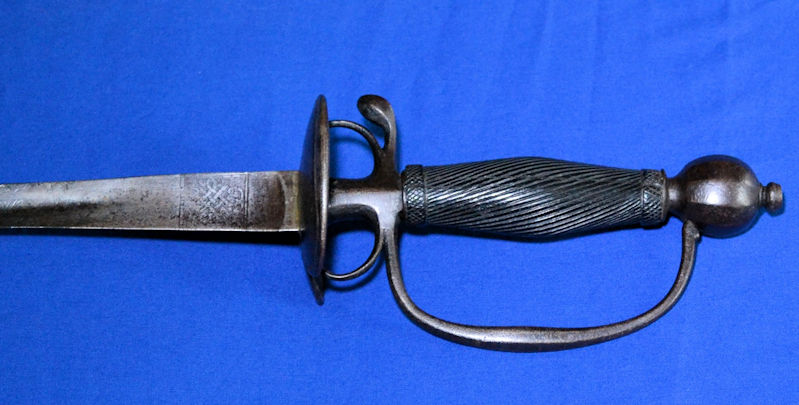
Certainly looks like a smallsword, certainly not from the Armada I'm afraid. The picture attached will give you some idea of the parts Glen says are missing. What is the length of your blade? Smallswords were typically around 31 inches I think, and thin with no real cutting edge.

| David Cooper wrote: |
| Jennifer
Certainly looks like a smallsword, certainly not from the Armada I'm afraid. The picture attached will give you some idea of the parts Glen says are missing. What is the length of your blade? Smallswords were typically around 31 inches I think, and thin with no real cutting edge. |
It may have been a loop hilt, as I don't see remnants/stubs of the pas d'ane. That would be typical for a fullered double edged example. I haven't had a chance yet to look through Neumann's, Lattimer's and some other resources.
Here are some loop hilts
http://www.swordforum.com/forums/showthread.p...mallswords
Cheers
GC
Glen
I think you are certainly right, although it looks to me as though there is a complete section of hilt missing from around the ricasso area. Perhaps it it just the way I am looking at the photos. I can see the fullered blade though which should have told me to expect a loop hilt :blush:
I think you are certainly right, although it looks to me as though there is a complete section of hilt missing from around the ricasso area. Perhaps it it just the way I am looking at the photos. I can see the fullered blade though which should have told me to expect a loop hilt :blush:
Really hard to say without brighter pictures or having it in hand. We don't know if the peen has been disturbed, etc. The thickness of the quillon remains would support more branches but how well was any of it dressed off, we just can't see. A gap between the blade and quillon block would maybe show there was once a shell of some type but if it has been apart and peened back, that would remove the gap. The peen capstan looks undisturbed, in that one good pommel profile picture but what does the end look like? I don't see this pommel shape before mid century, which would be another check mark for the loop hilt type. I am not finding an exacting match in the books or browsing. The loops seem predominately English.
Cheers
GC
Cheers
GC
A few more images to put up. With a blade that long and wide at the tip, maybe we should be looking a bit earlier and a transitional rapier? I just don't know That would put it back another century.
Cheers
GC
Stuff from image searching. I don't know the 17th century swords very well at all.
http://s273.photobucket.com/user/WindyHillTra...amp;page=1
http://www.antiqueweaponstore.com/Transitiona...201660.htm
http://www.oakeshott.org/update.html
https://www.facebook.com/events/962523957099020/
[ Linked Image ]
[ Linked Image ]
 Attachment: 11.57 KB
Attachment: 11.57 KB

 Attachment: 26.67 KB
Attachment: 26.67 KB
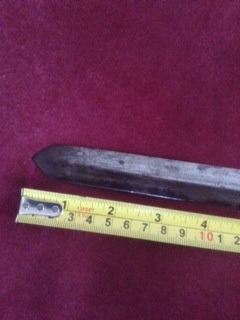
 Attachment: 24.38 KB
Attachment: 24.38 KB

Cheers
GC
Stuff from image searching. I don't know the 17th century swords very well at all.
http://s273.photobucket.com/user/WindyHillTra...amp;page=1
http://www.antiqueweaponstore.com/Transitiona...201660.htm
http://www.oakeshott.org/update.html
https://www.facebook.com/events/962523957099020/
[ Linked Image ]
[ Linked Image ]



Yes looks a bit too long for a smallsword. The tip looks truncated as well! The blade looks to have no taper or is that just the angle of the photo?
Here are some more photos. I hope this helps.
 Attachment: 19.35 KB
Attachment: 19.35 KB
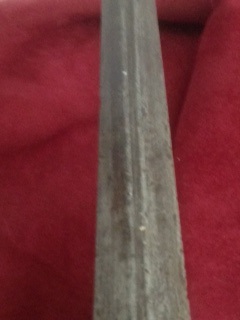
 Attachment: 24.15 KB
Attachment: 24.15 KB

 Attachment: 18.85 KB
Attachment: 18.85 KB

This is a photo from the end of the blade to the handle.
 Attachment: 24.2 KB
Attachment: 24.2 KB
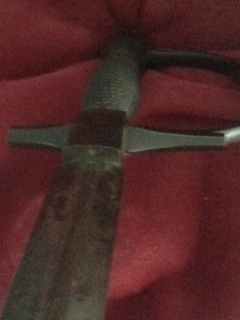
 Attachment: 23.61 KB
Attachment: 23.61 KB
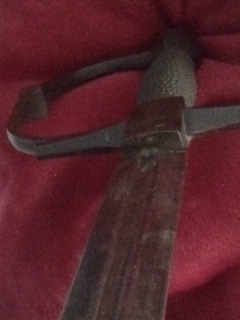



This is a photo from the end of the blade to the handle.


In my opinion, it is likely 20th century or possibly late 19th century at oldest.
It would be hard for me to date the hilt based on those pics alone, could be anything from 17th century to early 20th century though my gut says 18th or 19th century. With two cutting edges(slicing, really) it would be a rapier, not a small sword. The hilts and proportions are essentially the same and the method of use is very similar but they are distinct and were recognized as such by their users. This example has a long blade and a very odd point, the oxidation on the point looks fairly old but that doesn't mean that was the original point on the blade. It's possible it was a bull fighting weapon but it doesn't look like other examples I've seen, IMO it's more likely that this is one of the many weapon configurations that existed but are not often seen in literature because of bias among collectors and historians.
Page 1 of 1
You cannot post new topics in this forumYou cannot reply to topics in this forum
You cannot edit your posts in this forum
You cannot delete your posts in this forum
You cannot vote in polls in this forum
You cannot attach files in this forum
You can download files in this forum
All contents © Copyright 2003-2006 myArmoury.com — All rights reserved
Discussion forums powered by phpBB © The phpBB Group
Switch to the Full-featured Version of the forum
Discussion forums powered by phpBB © The phpBB Group
Switch to the Full-featured Version of the forum